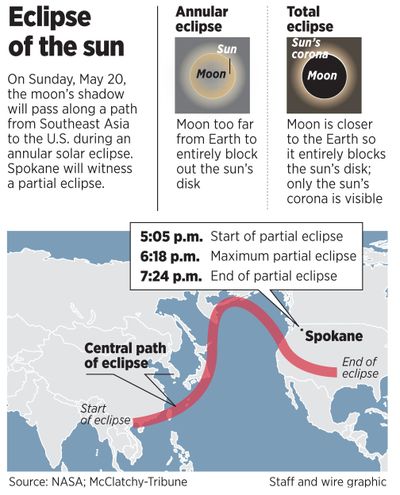Solar eclipse moves into view
A transit of Venus predicted on June 5

A partial solar eclipse on Sunday evening is going to darken one side of the sun to the delight of sky watchers in the Inland Northwest, but clouds could spoil the show.
The region will be on the northern side of the path of the annular eclipse running from Asia to Texas.
An approaching low pressure system is likely to send high, thin cirrus clouds over an otherwise sunny Inland Northwest, much like the clouds on Wednesday.
The clouds could partially or fully obscure the sun, depending on their thickness, said Steven Van Horn, forecaster for the National Weather Service in Spokane.
Locally, the moon will cover 72 percent of the sun at the height of the eclipse at 6:18 p.m.
Medford, Ore., Reno, Nev., and other western locations are in the path of full eclipse in which the moon will cover the center of the sun and allow a “ring of fire” to glow from the circumference.
Because the moon will have gone through apogee on Saturday, the moon will be at its farthest distance from Earth, making it appear slightly smaller than the sun. In a total eclipse, the moon is closer to Earth and obscures the sun fully without the ring.
A total eclipse will occur on Aug. 21, 2017, passing over north-central Oregon and central Idaho. Again, a partial eclipse will be seen from the Spokane area.
The moon’s orbit around the Earth occurs at an angle to the Earth’s path around the sun. Solar eclipses happen when the two orbital paths intersect during a new moon.
Sunday’s eclipse begins in Asia, where it will be Monday morning, and passes eastward across the Pacific Ocean, crossing the International Date Line into Sunday, according to NASA.
In Spokane, the moon will move in front of the sun starting at 5:05 p.m. Maximum coverage occurs a few seconds before 6:19 p.m. The partial eclipse ends here at 7:24 p.m.
Experts caution not to look directly at the sun because its powerful rays can damage the eyes. Special solar filters are used by astronomers.
An eclipse can be projected onto a white surface such as a paper plate or sidewalk with a small telescope or binoculars. The unused side of the binoculars or the finder scope opening on the telescope should be covered for safety.
A pinhole punched in a piece of paper or cardboard will also project the image.
The Spokane Astronomical Society is stepping up to give the public a direct look, said Jerry Eber, vice president.
Telescopes with filters will be set up at Sky Prairie Park near Strong and Five Mile roads and at the South Side Sports Complex at 46th Avenue and Regal Street.
“For our group it’s pretty exciting,” Eber said.
Unlike star and planet gazing, the solar eclipse “is something you can do in the daytime,” he said.
Sunday’s eclipse is one of two significant solar events coming within days of each other.
On June 5, Venus will move across the face of the sun in an unusual event known as a “transit.”
The orbit of Venus is inclined 3.4 degrees with respect to the Earth. The transit occurs when Venus crosses the plane of Earth’s orbit at the same time that Venus makes its closest pass of the sun from the perspective of Earth.
In some ways, a transit of Venus is similar to a solar eclipse except that Venus is relatively small in front of the sun and the frequency of the transits is much lower.
Transits of Venus follow a predictable pattern. The last transit was in 2004. The next transit won’t be for 105.5 years. Another transit occurs eight years later to be followed by a 121.5-year interval. That pattern repeats itself.
The transit in 2004 was not visible in the Inland Northwest.
Astronomical society members again will have their equipment set up for the public at the south side of Franklin Park near Queen Avenue and Division Street and at River Day School, 116 W. Indiana Ave. The transit begins at about 3:06 p.m. and lasts past sunset.